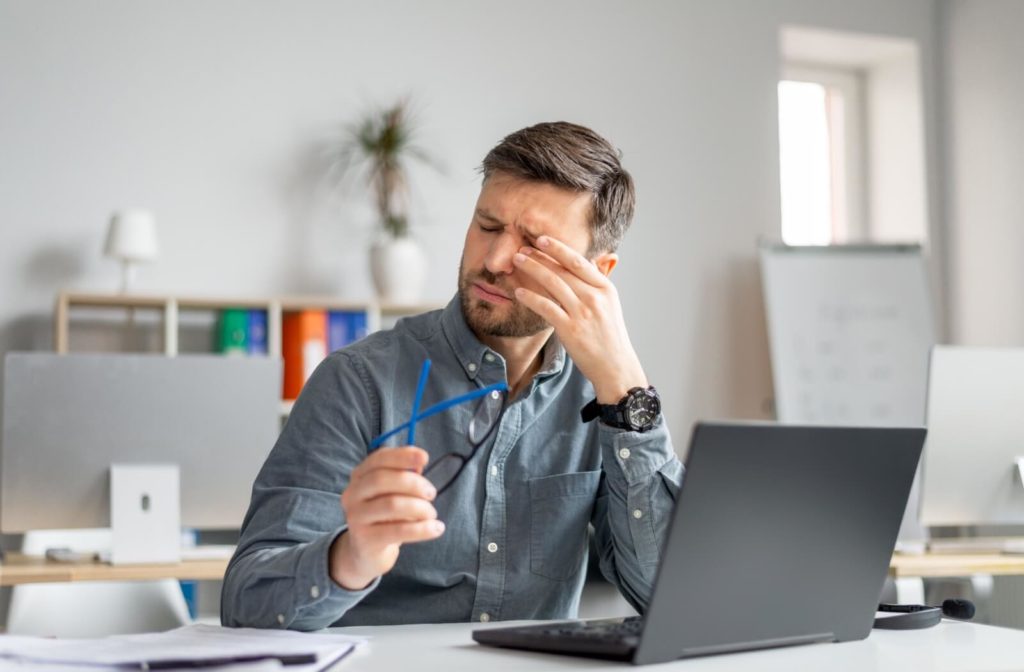Many people suffer from dry eyes, and the most common culprit is meibomian gland dysfunction (MGD). This condition affects the tiny glands in your eyelids, responsible for producing the oily layer of your tears. Without this essential oil, your tears evaporate quickly, leading to dry and irritated eyes.
We can treat meibomian gland dysfunction by unclogging the glands and promoting natural tear production. Whether you’re just starting to experience dryness or have been battling it for years, your optometrist can examine your symptoms and recommend solutions based on your situation.
What Is Meibomian Gland Dysfunction?
Meibomian gland dysfunction (MGD) happens when the meibomian glands, which line the margin of the eyelids, become blocked or don’t secrete enough oil. This oil forms part of the tear film, preventing tears from evaporating too quickly. When these glands malfunction, it leads to evaporative dry eye, the most common type of dry eye syndrome.
Recognizing the Symptoms
How do you know if you have MGD? Common symptoms include:
- Dryness and irritation in the eyes
- A gritty or sandy sensation
- Blurry vision
- Redness and inflammation around the eyelids
- Sensitivity to light
A frustratingly common symptom that’s worth noting is watery eyes. That’s right. You may notice an excessive amount of tears as your body tries to address the irritation, only for these tears to dry up before providing any relief.
Diagnosing MGD early is crucial. Untreated MGD can lead to chronic dry eye syndrome, which may cause damage to the eye’s surface and affect your vision. Regular eye check-ups can help detect MGD before it worsens, allowing for timely intervention.
What Causes MGD?
Several factors can increase your risk of developing MGD, including:
- Aging, as the glands naturally produce less oil as we get older.
- Hormonal changes, particularly in women during menopause.
- Allergies
- Wearing contact lenses
- Skin conditions, such as rosacea
- Immune system disorders, such as rheumatoid arthritis
- Blepharitis
At-Home Remedies for MGD
You may be able to address some mild MGD cases from the comfort of your own home. One of the simplest ways to manage MGD is through warm compresses. Applying a warmed dry eye mask to your eyelids could help melt any thickened oil within the glands, promoting better secretion.
- Warm your dry eye mask, like a Bruder Mask, in the microwave for 20 seconds.
- Place it over your closed eyelids for about 5–10 minutes.
Afterwards, you can gently massage your eyelids to help express the oil from the glands. You can also use artificial tears as you would for any other kind of dry eye if you need rapid relief.
Professional Treatments for MGD
For moderate to severe dry eye, you’ll likely need help from an eye care professional. An optometrist can review your medical history, symptoms, and lifestyle to better understand why you have dry eyes. With this information, we can draft a personalized plan that may include:
Warm Compresses & Lid Massages
While at-home warm compresses are beneficial, professional-grade compresses and massages performed by an eye doctor can provide more intensive relief. These treatments are designed to liquefy the gland secretions and improve their flow.
Prescription Eye Drops
For those who require additional relief beyond warm compresses, your eye doctor may recommend prescription medications. These could include:
- Antibiotic eye drops
- Anti-inflammatory eye drops
- Artificial tears with medication
Depending on what you require, this medication can reduce inflammation and control bacteria growth that’s causing MGD.
Tips for Preventing MGD
Prevention is easier than a cure, so if you can, stopping MGD before it takes hold can save you a whole lot of irritation. Here are some lifestyle changes you can use to reduce your risk of dry eye:
- Maintain good eyelid hygiene: Clean your eyelids using a mild, non-irritating cleanser. Baby shampoo diluted with water is a common choice or use eyelid wipes. Gently scrub the eyelid margins with a cotton swab or a clean washcloth.
- Stay hydrated and healthy: Staying hydrated and eating a balanced diet rich in eye-healthy vitamins. Focus on vitamins A and D.
- Blink regularly: Ensure you blink regularly, especially when using digital devices which can cause you to blink less. Blinking helps refresh your tears and prevent them from evaporating too quickly.
- Get regular eye check-ups: Regular visits to your eye doctor are essential for monitoring and maintaining eye health. These check-ups can help detect early signs of MGD and other eye conditions, allowing for timely intervention.
Say Goodbye to Dry Eyes
Taking care of your eyes is crucial, especially if you suffer from meibomian gland dysfunction. However, by understanding the condition, you’re already taking proactive steps to improve your quality of life!
Don’t wait any longer to take control of your eye health! Our team at Simcoe Optometric Clinic is dedicated to helping you achieve better eye comfort. We offer a comprehensive examination of your symptoms so we can provide personalized care and precise treatment for meibomian gland dysfunction.Book your appointment now and start your journey to healthier eyes today!



